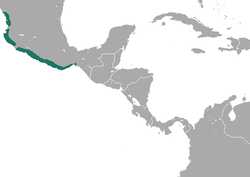| Pygmy spotted skunk [1] | |
|---|---|
| Scientific classification | |
| Kingdom: | Animalia |
| Phylum: | Chordata |
| Class: | Mammalia |
| Order: | Carnivora |
| Suborder: | Caniformia |
| Family: | Mephitidae |
| Genus: | Spilogale |
| Species: | S. pygmaea |
| Binomial name | |
| Spilogale pygmaea Thomas, 1898 | |
 | |
Pygmy spotted skunk range | |
The pygmy spotted skunk (Spilogale pygmaea) is a species of mammal in the family Mephitidae. It is endemic to Mexico.
